 W
WThe Adoration of the Magi is a painting by the Italian late Renaissance painter Correggio, executed around 1515–1518. It is housed in the Pinacoteca di Brera of Milan, Italy.
 W
WThe Adoration of the
 W
WThe Assumption Altarpiece was a 1529-1530 multi-panel painting by Moretto da Brescia. It is mainly oil on panel, although the two angels on the cornice are in tempera grassa verniciata.
 W
WBacino di San Marco from the Puntana della Dogana is a 1740-1745 oil on canvas painting by Canaletto, now in the Pinacoteca di Brera in Milan. It forms a pair with The Grand Canal looking towards Punta della Dogana from Campo Sant'Ivo, with both works produced in the artist's mature period just before his move to London.
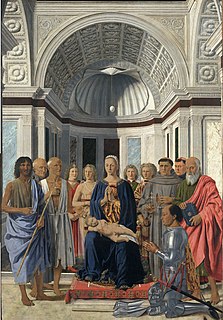 W
WThe Brera Madonna is a painting by the Italian Renaissance master Piero della Francesca, executed in 1472–1474. It is housed in the Pinacoteca di Brera of Milan, where it was deposited by Napoleon.
 W
WChrist and the Samaritan Woman or The Woman at the Well is a 1593-1594 oil on canvas painting by Annibale Carracci, painted as part of the same scheme as the Palazzo Sampieri frescoes. Several years later he also produced a much smaller autograph copy with variations, now in the Museum of Fine Arts, Budapest.
 W
WLampugnani's Conspiracy is an 1826 oil on canvas painting by Francesco Hayez, now in the pinacoteca di Brera in Milan, which acquired it in 1907. It shows the conspiracy led by Giovanni Andrea Lampugnani, Girolamo Olgiati, Carlo Visconti and Cola Montano to overthrow the tyranny of Galeazzo Maria Sforza, killed on 26 December 1476 in Santo Stefano church in Milan.
 W
WPenitent Saint Jerome is a painting in oil and tempera on panel by Cosmè Tura, probably of around 1470, which has been in the National Gallery in London since 1867.
 W
WCrucifixion is an oil painting on panel of c. 1510–1512 by Bramantino in the Pinacoteca di Brera, Milan. It was first recorded in that gallery's collections in 1806, without any earlier provenance.
 W
WPietà or The Dead Christ Supported by the Virgin Mary and St John the Evangelist is a tempera on panel painting by Giovanni Bellini, now in the Pinacoteca di Brera in Milan.
 W
WThe Feast in the House of Simon the Pharisee is an oil on canvas painting by Paolo Veronese, completed in 1570 for San Sebastiano, a Hieronymite monastery in Venice. He also produced a cycle of works for the monastery church, where he was later buried. After the French occupation of Venice in the late 18th century, the monastery was suppressed and its art confiscated. In 1817, after the fall of Napoleon, Feast was assigned to the Pinacoteca di Brera in Milan, where it still hangs.
 W
WThe Finding of the Body of Saint Mark or Discovery of the Body of Saint Mark is a painting by Tintoretto. Dated to between 1562 and 1566, it is part of a cycle of paintings of Saint Mark, the patron saint of Venice. It is now held in the Pinacoteca di Brera in Milan.
 W
WThe Flagellation Standard was a double-sided tempera on panel painting by Luca Signorelli, signed "LUCE CORTONENSIS". Its stylistic similarities to Piero della Francesca date it to 1475, during Signorelli's first stay in Marche. Several historians consider it to be his earliest surviving work.
 W
WThe Greek Madonna is a 1460–1470 tempera on panel painting by Giovanni Bellini. It is named after the Greek monograms at top left and top right and after the major influence of Byzantine icons on the painting. The Christ Child holds a golden apple, perhaps referring to the Judgement of Paris and to Mary as the "new Venus".
 W
WIl bacio is an 1859 painting by the Italian artist Francesco Hayez. It is possibly his best known work. This painting conveys the main features of Italian Romanticism and has come to represent the spirit of the Risorgimento. It was commissioned by Alfonso Maria Visconti di Saliceto, who donated it to the Pinacoteca di Brera after his death.
 W
WThe Lamentation of Christ is a painting of about 1480 by the Italian Renaissance artist Andrea Mantegna. While the dating of the piece is debated, it was completed between 1475 and 1501, probably in the early 1480s. It portrays the body of Christ supine on a marble slab. He is watched over by the Virgin Mary and Saint John and St. Mary Magdalene weeping for his death.
 W
WThe Last Supper is a painting by Daniele Crespi.
 W
WThe Last Supper (1630–1631) is an oil painting by Peter Paul Rubens. It was commissioned by Catherine Lescuyer as a commemorative piece for her father. Rubens created it as part of an altarpiece in the Church of St. Rombout (Rumbold) in Mechelen. The painting depicts Jesus and the Apostles during the Last Supper, with Judas dressed in blue turning back towards the viewer and away from the table. Other than Jesus, the most prominent figure is Judas. Judas holds his right hand to his mouth with his eyes avoiding direct contact with the other figures in the painting creating a nervous expression. Jesus is dressed in red and has a yellow halo surrounding his head with his face tilted upwards. Jesus is located centrally in the painting surrounded by his disciples with six on each side, and he holds a loaf of bread with a cup of wine in front of him. Out of all of the figures, he is the most in the light with the figures to the farthest left being the most in shadow. “The scene thus represents a perfect conflation of the theological significance of the Last Supper” meaning the conflation between the blessing of the bread and the wine while still being pivotal in the sense of revealing the betrayal.
 W
WThe 'Madonna and Child or Madonna with the Christ Child Blessing is a 1510 oil on panel painting by Giovanni Bellini, painted when he was already in his eighties but still responding to new developments in painting. It is similar to the 1505 Madonna del Prato and the 1509 Madonna and Child. It is now in the Pinacoteca di Brera in Milan.
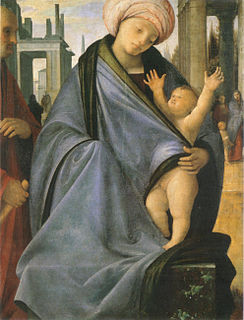 W
WMadonna and Child with a Man or Madonna and Child with a Male Figure is an oil painting on panel of c. 1503–04 by Bramantino in the Pinacoteca di Brera in Milan, which it entered in 1896. The painting had previously been in the collection of cardinal Cesare Monti, left to the Archdiocese of Milan in 1650. Its previous provenance is unknown, though its small dimensions suggest that it was intended for private devotion.
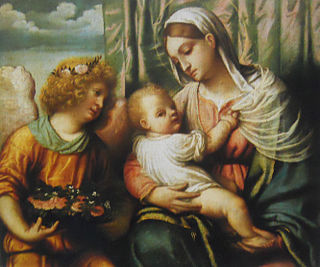 W
WMadonna and Child with an Angel is a c.1540-1550 oil on canvas painting by Moretto da Brescia, now in the Pinacoteca di Brera in Milan, which acquired it in 1911. It had previously been in Gustavo Frizzoni's collection.
 W
WMadonna and Child with Four Saints is a c.1543 oil on canvas painting by Moretto da Brescia, now in the Pinacoteca di Brera in Milan, to which it moved during the Napoleonic seizures in 1808. It was painted for the church of Santa Maria degli Angeli in Gardone Val Trompia. In the foreground are Jerome, Francis of Assisi and Anthony the Great.
 W
WThe Madonna with the Cherubim is a c.1485 painting by the Italian Renaissance painter Andrea Mantegna.
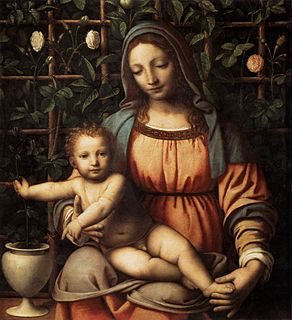 W
WMadonna of the Rose Garden is a c.1510 oil on panel painting by Bernardino Luini, now in the Pinacoteca di Brera in Milan, which acquired it from the Giuseppe Bianchi collection in 1826.
 W
WThe Marriage of the Virgin, also known as Lo Sposalizio, is an oil painting by the Italian High Renaissance artist Raphael. Completed in 1504 for the Franciscan church of San Francesco, Città di Castello, the painting depicts a marriage ceremony between Mary and Joseph. It changed hands several times before settling in 1806 at the Pinacoteca di Brera.
 W
WMelancholy is an 1840-1841 oil on canvas painting by the Italian artist Francesco Hayez, now in the pinacoteca di Brera in Milan.
 W
WMystic Marriage of Saint Catherine is a c.1616-1620 oil on canvas painting by Giulio Cesare Procaccini, now in the Pinacoteca di Brera in Milan. It is one of the artist's last works, influenced by Correggio, Titian's allegories and Leonardo da Vinci's The Virgin and Child with Saint Anne (Louvre).
 W
WNativity with St Elizabeth and the Infant John the Baptist is a c.1512-1513 oil on panel painting by Correggio, now in the Pinacoteca di Brera in Milan, which acquired it at an auction in Paris in 1913.
 W
WThe Palazzo della Ragione Madonna is a fragment of a fresco of c. 1509–10 by Bramantino, originally on the façade of the Palazzo della Ragione, Milan, and now in the Pinacoteca di Brera in the same city. Due to a reference by Giovanni Paolo Lomazzo it was long misattributed to Bramante, until it entered its present home in 1808.
 W
WPietà is an oil on canvas painting by Lorenzo Lotto, signed "Laurentio Lotto". It is mentioned in Lotto's account books as being commissioned in 1538 for the altar dedicated to the Pietà in the Dominican church of San Paolo in Treviso. The account books also mention that the work was completed in 1545. That church was suppressed under the Napoleonic regime late in the 18th century and in 1811 the painting was bought for 12 ducats by the Pinacoteca di Brera in Milan, where it still hangs.
 W
WPietro Rossi is an 1818-1820 oil on canvas painting by the Italian artist Francesco Hayez, now in the San Fiorano collection in Milan. A copy is in the Pinacoteca di Brera, also in Milan. Both show Pietro Rossi, accepting an invitation from Francesco Dandolo via a messenger to take command of the Venetian resistance to the expansionist Scaligeri. The work links a heroic past event to contemporary events and a Romantic sensitivity, as in historical novels of the same period such as Alessandro Manzoni's 1840 The Betrothed.
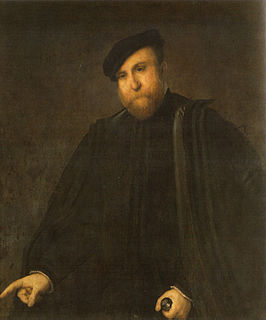 W
WPortrait of a Man is an oil on canvas painting by Lorenzo Lotto, dated to around 1545 due to its stylistic similarities to the artist's other works in the mid-1540s such as Portrait of an Old Man with Gloves (Milan). Another theory holds that the subject is Giovanni Taurini da Montepulciano, viceroy of Ancona, which would change the date to 1551, the year of Lotto's arrival in Ancona. It is now in the Pinacoteca di Brera in Milan, which it entered in 1855 as part of the Oggioni Bequest.
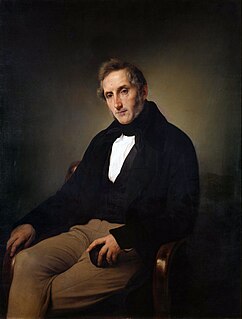 W
WPortrait of Alessandro Manzoni is an 1841 oil on canvas portrait of Alessandro Manzoni by Francesco Hayez, now in the Pinacoteca di Brera. It was commissioned in 1840 by Manzoni's second wife countess Teresa Borri Stampa and his son Stefano. After fifteen sittings the painter completed the work on 26 June 1841. Eight years later Teresa commissioned a portrait of herself by the same artist.
 W
WPortrait of an Old Man with Gloves is an oil on canvas painting by Lorenzo Lotto, signed "L. Loto" and dated to around 1543 due to stylistic similarities with Portrait of Febo da Brescia, Portrait of a Thirty-Seven-Year-Old Gentleman and other works produced by the artist in the mid 1540s. Its final private owner was count Castellane Harrach of Turin, from whose collection it entered the Pinacoteca di Brera in Milan in 1859, where it still hangs.
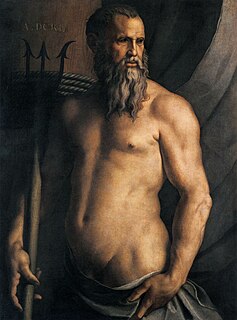 W
WThe Portrait of Andrea Doria as Neptune is an oil painting on canvas completed by Bronzino for a private collection in either the 1530s or 1540s. It is now in the Pinacoteca di Brera in Milan, Italy. An oil painting on canvas, it measures 199.5 centimetres (78.5 in) by 149 centimetres (59 in). In a conscious revival of the convention in classical sculpture of showing important political figures in heroic nudity, it depicts the Genoan admiral, Andrea Doria, posing as the classical god of the sea, Neptune.
 W
WPortrait of Febo da Brescia is a 1543-1544 oil on canvas painting by Lorenzo Lotto. It is identified with the commission mentioned in the artist's account books in April 1543 from Febo Bettignoli da Brescia, a nobleman from Treviso, for paintings of himself and his wife, which were delivered in 1544. After Febo's death in 1547 the painting passed to his wife's heirs and remained with them until her family died out in the 19th century. In 1859, via Francesco Hayez the painter, the Pinacoteca di Brera acquired the paintings of Febo and his wife - they still hang there.
 W
WPortrait of Laura da Pola is a 1543-1544 oil on canvas painting by Lorenzo Lotto. Its subject was the wife of Febo Bettignoli da Brescia, a nobleman from Treviso, who commissioned this work and its pair from Lotto in April 1543, as recorded in the painter's account books. They were delivered in 1544 and after Febo's death in 1547 remained with his wife's descendants until her family died out in the 19th century. Both works were acquired in 1859 by the Pinacoteca di Brera, where they still hang
 W
WPortrait of Minerva Anguissola is a c. 1564 oil on canvas painting by Sofonisba Anguissola, now in the Pinacoteca di Brera in Milan.
 W
WPortrait of Teresa Manzoni Stampa Borri is an 1849 oil on canvas painting by Francesco Hayez, now in the Pinacoteca di Brera in Milan, to which it was given in 1900 by Stefano Stampa, the subject's son by her first marriage. She had also commissioned Portrait of Alessandro Manzoni from Hayez, showing her second husband, also in the Brera.
 W
WSt. Bernardino of Siena between Two Angels is a painting attributed to the Italian Renaissance artist Andrea Mantegna and his assistants, dated to 1460 and housed in the Pinacoteca di Brera of Milan.
 W
WSaint Jerome in Penitence is a c. 1552 painting by Titian.
 W
WThe San Domenico di Pesaro Altarpiece is a 1524-1526 oil on panel painting by Giovanni Gerolamo Savoldo, now in the Pinacoteca di Brera in Milan. The work dates to the same period as Savoldo's Rest on the Flight into Egypt, also produced for San Domenico. It shows the Madonna and Child seated between two angel musicians, while in the lower register it shows Saint Peter, Saint Dominic, Saint Paul and Saint Jerome.
 W
WThe San Gottardo Altarpiece is an oil on canvas painting by Giovanni Cariani, previously dated to 1520 but now thought to have been begun in 1517 and completed in 1518. This made it perhaps his first major work and certainly the first work he produced in Bergamo after arriving there on 15 August 1517 - St Joseph was the city's patron saint. It was commissioned as an altarpiece by the council of the Scuola di san Giuseppe for the church of San Gottardo. There was tension between the commissioners and the artist and - instead of Cariani - they opted for Lorenzo Lotto and Previtali for the larger works in the church.
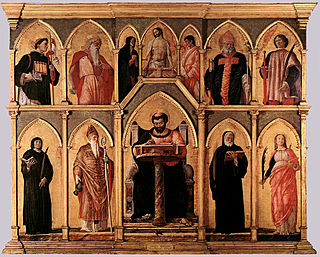 W
WThe San Lucas Altarpiece, also known as the San Lucas Polyptych, is a polyptych panel painting by Northern Italian Renaissance painter Andrea Mantegna. The altarpiece is a polyptych panel painting featuring 12 figures each in his or her own arch. The seven figures in the top row flank the central figure of Jesus Christ. The five beneath flank Saint Luke.
 W
WThe Santa Maria in Porto Altarpiece is a painting by the Italian Renaissance painter Ercole de' Roberti, executed in 1479-1481 and housed in the Pinacoteca di Brera, Milan, northern Italy.
 W
WSt Peter Martyr with St Nicholas and St Benedict is an oil on canvas painting by Cima da Conegliano, created c. 1505-1506, now in the Pinacoteca di Brera in Milan. It references the sacra conversazione pieces by Giovanni Bellini, whilst the landscape shows the artist as an early adopter of the new style of Giorgione.
 W
WSupper at Emmaus (1606) is a painting by the Italian master Caravaggio, housed in the Pinacoteca di Brera, Milan.
 W
WTransfiguration is a c.1515-1516 tempera on panel painting by Pordenone, now in the Pinacoteca di Brera in Milan.
 W
WThe Transfigured Christ is a 1513 oil on panel painting by Andrea Previtali, in the Pinacoteca di Brera in Milan since 1811 It is signed and dated Al Nobel homo mr/Andrea dipintor in/Bergamo/MDXIII on a small book at bottom right.
 W
WThe Valle Romita Polyptych is a painting by the Italian late Gothic painter Gentile da Fabriano, dating from c. 1410-1412 and now housed in the Pinacoteca di Brera in Milan. It was originally executed for the Franciscan hermitage of Valle Romita near Gentile's birthplace, Fabriano.
 W
WThe Villa La Pelucca frescoes are a 1520-1523 cycle of frescos by Bernardino Luini, commissioned by the Milanese nobleman Gerolamo Rabia for his villa near Monza, known as 'La Pelucca'. Most of the surviving fragments are in the Pinacoteca di Brera in Milan, though others are in the Wallace Collection in London, the Louvre in Paris, the Musée Condé in Chantilly and other private collections. Stylistically they shown the influence of Bramantino - Women Bathing the figure's shoulders is a homage to the Trivulzio Tapestries, particularly February from that cycle.